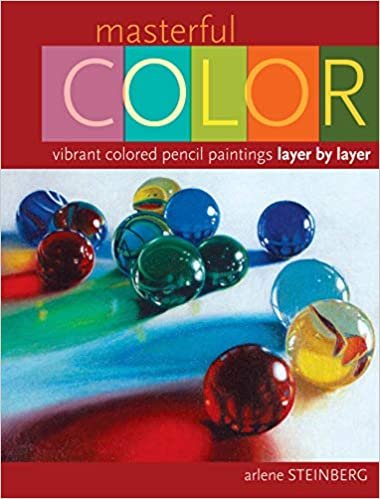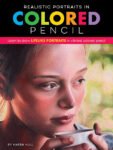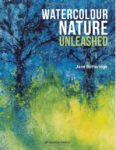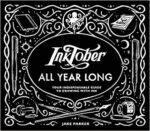And here's the last of my Christmas books. It's a 144 page paperback, slightly oversized…

Masterful Color, Vibrant Colored Pencil Paintings Layer By Layer: Arlene Steinberg – Book Review
Ok. I’ve been looking for a while for a book on coloured pencils that was suitable for a complete beginner after the Encyclopaedia Of Coloured Pencil Techniques left me feeling a bit let down. I found this 144 page paperback by accident while googling around and it sounded as if it might be the book I needed. But was it?
The book can be divided into two parts. The first third is a beginner’s introduction to coloured pencil and the rest of the book is a series of demonstrations.
In that first third, there’s a chapter on how to use coloured pencils, then a couple more chapters on composition and colours/values. I didn’t learn much from that second and third chapter but I don’t begrudge them being there. One of the points I keep making about beginners’ books is that they need to take the reader on a journey, and I don’t think these chapters could have been left out. The concept of complementary colours is key to the demonstrations and compositional planning is included in the big demonstration at the end of the book.
That first chapter, though, is excellent. I learned more in that first chapter than in the whole of the Encyclopaedia Of Coloured Pencil Techniques. I learned about so many things that I’ve been doing wrong. I’ve been holding my pencil too near the point. I’ve been filling in areas by shading with the edge of the lead when I should have been scribbling faintly in very small circles with a very sharp pencil. I’ve been burnishing with a sharp pencil when I should have been using a blunt one. I could go on. Suffice to say, it’s off the charts.
And then we get to the demonstrations. There are 14 normal demonstrations followed by one huge demonstration that includes thoughts on composition and where the final painting is a combination of several of the individual paintings. I have so many comments to make on these demonstrations that it’s difficult to string them together into a discourse, so I’m going to give a list of bullet points:
– the demos are an important part of the book, introducing the idea of using pencils in multiple layers
– the colours to use in that first layer depend on what the final colours are going to look like. This is the big idea idea in the book. The first three demonstrations discuss red, yellow and blue subjects. These all require different colours in the underpainting, so all needed separate demonstrations.
– each demonstration has six or seven steps and each step can involve adding up to four or five layers to different areas of the painting. There’s a big lesson there about how many layers to add.
– the demos are prescriptive. Too much do this, do that and not enough I did this, I did that.
– in particular the demos are very prescriptive about what colour pencils to use. People who religiously follow the instructions are complaining about having to buy new pencils to be able to follow the demos. Those who are happy to use similar but different colours or those (like me) who are happy to read and learn from demos, then do our own paintings are more chilled.
– the most useful bits of the demos (in my opinion) and at the very beginning and at the end. The middle steps, where Arlene tells us to layer over this green and then this red I take with a pinch of salt. In reality, surely you look at the coloured area, then decide what colour you need to lay over next rather than just following instructions?
– I thought there were too many demonstrations. About halfway through them, I was switching off and skim reading. I’d got the general idea about how to start and finish a painting and that the bit in the middle was all about adding multiple layers.
– The reason for there being so many demos was probably that the later ones got more complicated with glasswork, metal bowls, china cups and other textures. At this stage of the book there seemed to be a big jump in realism and I think the book could have benefited from more discussion about the techniques to use in painting all those different textures rather than just showing us more demos with not much help apart from telling us to paint what we see, not what we think we see.
– a minor point but the demos all told us to spray fixative on the finished paintings. I thought this was something that was only required for oily pencils and not for waxy ones like my Polychromoses. If this is the case, then Arlene should really have told us this, what with this presumably being a beginners’ book.
The book as a whole (including the demonstrations) is very much focused on still life paintings. This is a subject area that’s not that interesting to me but I’m not complaining. I bought this book to learn how to draw with coloured pencils, not to copy all the examples. And still life gave Arlene ample opportunity to dig out the red, yellow and blue (and later white, metal and glass) subject matter that she needed to illustrate her advice in the demos. I’m actually looking forward to applying the techniques in this book to figures, portraits and even landscapes.
This is definitely a good book and is the one that I’m pointing anybody towards if they want an introductory coloured pencil book. Provided either they use Prismacolour pencils or they’re smart enough to be able to read Prismacolour pencil demos and apply the lessons to their own paintings using their own brand of pencils. It’s a tough call on how to grade this one though. It’s a good book so definitely worth three palettes. But I was frustrated in the final third by having too many demos and not enough explanation of how to paint glass/metal/china, so it’s definitely not a five palette galactico. It’s between three and four palettes, and I’m going to round it down. Remember three palettes is a good score. And that this is the best beginners’ book I’ve seen on coloured pencils.
🎨🎨🎨
You can find this book and more reviews of it at Amazon UK here. As an Amazon Associate, I earn commission from qualifying purchases but this costs absolutely nothing extra to you.








Leave a Reply